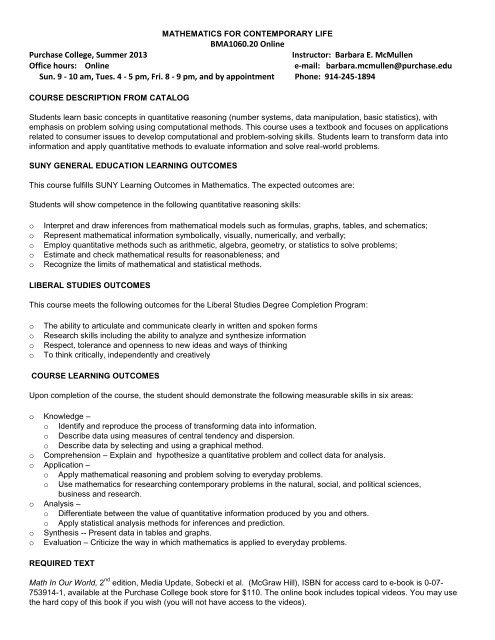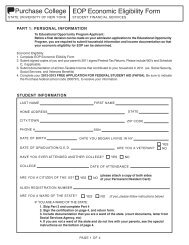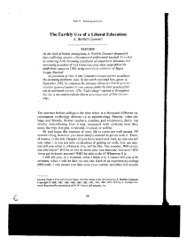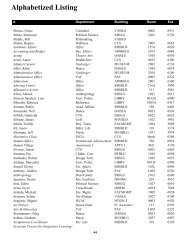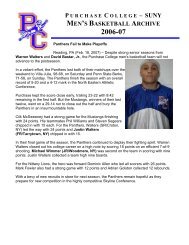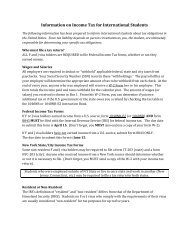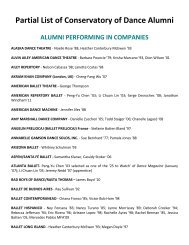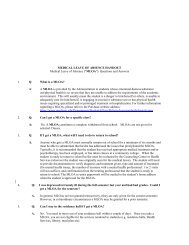Mathematics for Contemporary Life - Purchase College
Mathematics for Contemporary Life - Purchase College
Mathematics for Contemporary Life - Purchase College
You also want an ePaper? Increase the reach of your titles
YUMPU automatically turns print PDFs into web optimized ePapers that Google loves.
MATHEMATICS FOR CONTEMPORARY LIFE<br />
BMA1060.20 Online<br />
<strong>Purchase</strong> <strong>College</strong>, Summer 2013<br />
Instructor: Barbara E. McMullen<br />
Office hours: Online e-mail: barbara.mcmullen@purchase.edu<br />
Sun. 9 - 10 am, Tues. 4 - 5 pm, Fri. 8 - 9 pm, and by appointment Phone: 914-245-1894<br />
COURSE DESCRIPTION FROM CATALOG<br />
Students learn basic concepts in quantitative reasoning (number systems, data manipulation, basic statistics), with<br />
emphasis on problem solving using computational methods. This course uses a textbook and focuses on applications<br />
related to consumer issues to develop computational and problem-solving skills. Students learn to trans<strong>for</strong>m data into<br />
in<strong>for</strong>mation and apply quantitative methods to evaluate in<strong>for</strong>mation and solve real-world problems.<br />
SUNY GENERAL EDUCATION LEARNING OUTCOMES<br />
This course fulfills SUNY Learning Outcomes in <strong>Mathematics</strong>. The expected outcomes are:<br />
Students will show competence in the following quantitative reasoning skills:<br />
o<br />
o<br />
o<br />
o<br />
o<br />
Interpret and draw inferences from mathematical models such as <strong>for</strong>mulas, graphs, tables, and schematics;<br />
Represent mathematical in<strong>for</strong>mation symbolically, visually, numerically, and verbally;<br />
Employ quantitative methods such as arithmetic, algebra, geometry, or statistics to solve problems;<br />
Estimate and check mathematical results <strong>for</strong> reasonableness; and<br />
Recognize the limits of mathematical and statistical methods.<br />
LIBERAL STUDIES OUTCOMES<br />
This course meets the following outcomes <strong>for</strong> the Liberal Studies Degree Completion Program:<br />
o<br />
o<br />
o<br />
o<br />
The ability to articulate and communicate clearly in written and spoken <strong>for</strong>ms<br />
Research skills including the ability to analyze and synthesize in<strong>for</strong>mation<br />
Respect, tolerance and openness to new ideas and ways of thinking<br />
To think critically, independently and creatively<br />
COURSE LEARNING OUTCOMES<br />
Upon completion of the course, the student should demonstrate the following measurable skills in six areas:<br />
o Knowledge –<br />
o Identify and reproduce the process of trans<strong>for</strong>ming data into in<strong>for</strong>mation.<br />
o Describe data using measures of central tendency and dispersion.<br />
o Describe data by selecting and using a graphical method.<br />
o Comprehension – Explain and hypothesize a quantitative problem and collect data <strong>for</strong> analysis.<br />
o Application –<br />
o Apply mathematical reasoning and problem solving to everyday problems.<br />
o Use mathematics <strong>for</strong> researching contemporary problems in the natural, social, and political sciences,<br />
business and research.<br />
o Analysis –<br />
o Differentiate between the value of quantitative in<strong>for</strong>mation produced by you and others.<br />
o Apply statistical analysis methods <strong>for</strong> inferences and prediction.<br />
o Synthesis -- Present data in tables and graphs.<br />
o Evaluation – Criticize the way in which mathematics is applied to everyday problems.<br />
REQUIRED TEXT<br />
Math In Our World, 2 nd edition, Media Update, Sobecki et al. (McGraw Hill), ISBN <strong>for</strong> access card to e-book is 0-07-<br />
753914-1, available at the <strong>Purchase</strong> <strong>College</strong> book store <strong>for</strong> $110. The online book includes topical videos. You may use<br />
the hard copy of this book if you wish (you will not have access to the videos).
PURCHASE COLLEGE ACADEMIC INTEGRITY POLICY<br />
The <strong>Purchase</strong> <strong>College</strong> Academic Integrity Policy<br />
<br />
explicitly <strong>for</strong>bids cheating, plagiarism and other <strong>for</strong>ms of academic dishonesty. Plagiarism is the appropriation or imitation<br />
of the language, ideas, and/or thoughts of another person and the representation of them as one's own original work.<br />
Students are responsible <strong>for</strong> familiarizing themselves with the definition of plagiarism and the acceptable methods of<br />
attribution.<br />
Violation of any of the above may lead to <strong>for</strong>mal disciplinary action and the following sanctions:<br />
o<br />
o<br />
o<br />
Minimum Sanction: Failing grade on the assignment or examination. Maximum Sanction: Expulsion<br />
Recommended Sanction (First Offense): Failing grade <strong>for</strong> the course<br />
Recommended Sanction (Second Offense): Expulsion<br />
Students who have any questions or doubts about whether any activity is academically permissible, should check with me<br />
first.<br />
DOCUMENTED DISABILITIES<br />
Students with documented physical, learning, psychological and other disabilities are entitled to receive reasonable<br />
accommodations. If a student needs accommodations, he or she must first register with the Office of Special Student<br />
Services; please call 914-251-6390 or email accommodations@purchase.edu.<br />
You can find a description of special student services provided by the Counseling Center at:<br />
http://www.purchase.edu/Departments/SpecialStudentServices/<br />
Moodle is ADA compliant; you can find the accessibility specification <strong>for</strong> Moodle at:<br />
http://docs.moodle.org/en/Moodle_Accessibility_Specification<br />
COURSE REQUIREMENTS<br />
1. Attendance Policy / Participation<br />
Attendance and punctuality are expected.<br />
o<br />
o<br />
Attendance will be taken at every class as demonstrated by your completion of daily activities.<br />
Your presence is vital <strong>for</strong> participation in varied learning activities and small group work.<br />
3. Tests<br />
You will be given two tests over the course of the semester. They must be completed in a specified time frame. They<br />
are open book. You can use a calculator, your notes, and the class PowerPoint slides.<br />
4. Homework<br />
Ten problem sets are assigned over the course of the semester. They are due one day after they are assigned.<br />
5. Daily Real World Activities<br />
There are a total of 25 activities in this category. They consist of short quizzes, <strong>for</strong>ums, and questionnaires to assess<br />
learning objectives and other activities, such as Excel labs and a 4-part project, that demonstrate your understanding of<br />
the subject matter.
6.Tools Used<br />
Required Spreadsheet Software: Microsoft Excel (PC Version 2007 or 2010). If you do not have this software, you should<br />
plan to use the free Excel app available at Windows Live, SkyDrive, or Google Docs, or OpenOffice.<br />
Required Statistical Software: For a PC (not a Mac) you can use the Excel Data Analysis Add-in <strong>for</strong> PC Version 2007 or<br />
2010. Be certain you have the add-in available to you. If you do not have access to Excel Version 2007 or 2010 on a PC<br />
with the Add-in, then you will need StatCrunch, available online at www.statcrunch.com <strong>for</strong> $12.<br />
Calculator: A Texas Instrument BA II Plus calculator (or similar) is suggested, but any calculator will do the job.<br />
7. Your <strong>Purchase</strong> Email Account<br />
You must check your e-mail daily. You must keep your e-mail account open and make sure there is room <strong>for</strong> incoming<br />
messages. Not checking your e-mail regularly and messages not received because your mailbox is full are not excuses<br />
<strong>for</strong> being ignorant of materials and assignments sent by e-mail.<br />
Go to http://studentservices.purchase.edu/ to activate your account.<br />
8. Moodle:<br />
o<br />
o<br />
o<br />
o<br />
o<br />
o<br />
o<br />
o<br />
An on-line course management system called Moodle will be used <strong>for</strong> assignments, announcements, and learning<br />
resources used in this course.<br />
All students are required to participate in the Moodle assignments; it will be assumed that all announcements on<br />
this site have reached you, so be sure to check it frequently.<br />
Go to www.purchase.edu/studenttutorial and review the Moodle tutorial, designed to help you become familiar<br />
with how to use Moodle.<br />
To access your course in Moodle, first set up your <strong>Purchase</strong> email account if you have not done so already; log in<br />
with your <strong>Purchase</strong> username and password at http://moodle.purchase.edu; (do not put “@purchase.edu). Your<br />
course will appear on the left side of the page under “My Courses.”<br />
Set up your profile: “Profile” button from the Administration box on the left side of our class page; select the “edit<br />
profile” tab at the top, and be sure that your first name, last name, and e-mail address are correct (other options<br />
are OK as is, but you may change them if you wish).<br />
Also in the administration box, you will see a link to the gradebook where you may check on your grades on the<br />
Moodle quizzes and <strong>for</strong>ums.<br />
For technical/email assistance, CTS: (914) 251-6465 or Helpdesk@purchase.edu.<br />
For Moodle specific questions, email TLTC@purchase.edu.<br />
Materials (weekly schedule, updated as necessary; homework assignments; classroom materials; Powerpoint<br />
lecture notes; other notes and instructions; quizzes) are posted on-line on Moodle.<br />
GRADING<br />
Your grade will depend on your per<strong>for</strong>mance on daily math assignments, two quizzes, one group term project (in 2 parts)<br />
and participation, which are weighted as follows:<br />
Weekly Problem Sets<br />
Tests (2)<br />
Daily Real World Applications, Activities, and Review Quizzes<br />
Overall Participation (Includes an appearance at a minimum<br />
of 2 out of 4 interactive chats with the class and me.)<br />
5 pts each X 10 = 50% (total)<br />
10 points each X 2 = 20% (total)<br />
1 pt each X 25 = 25% (total)<br />
5%
Extra Credit:<br />
Best, Joel. “Damned Lies and Statistics: Untangling Numbers from the Media, Politicians, and Activists.” University of<br />
Cali<strong>for</strong>nia Press. Berkeley and Los Angeles, Cali<strong>for</strong>nia, 2001. Read and critique specific examples.<br />
Jones, Gerald E. “How To Lie With Charts: Second Edition.” Booksurge Llc. 2006. Read and critique specific examples.<br />
Huff, Darrell. “How To Lie With Statistics.” W.W. Norton & Company, New York, 1993. Read and critique specific<br />
examples.<br />
CLASS SCHEDULE<br />
A separate document on Moodle outlines each week’s class focus and homework.<br />
Review the schedule posted on Moodle be<strong>for</strong>e each class <strong>for</strong> changes and additions.


